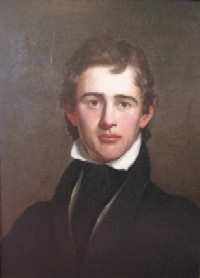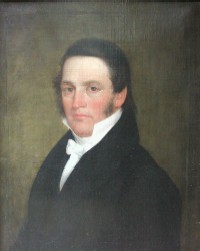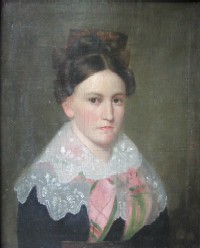Rare Corwine Portraits: Find New Home at The Filson
By Estill Curtis Pennington
Visiting Curator of Fine and Decorative Arts
Currently a Smithsonian Fellow
 Corwine was born in Maysville, Kentucky to early settlers of
Mason County. Before becoming an artist, Aaron was “a ploughboy, for which he
never showed much taste,” according to the antiquarian historian Lewis
Collins. Collins’ mythic history of Corwine includes an episode of painting his
father’s barns and fences with “grotesque figures” which were so “fanciful and
striking” that his father, Amos Corwine, determined to give him “the
opportunity to pursue the inclination of his mind.” After a brief period of
study with a local portraitist, an unidentified Mr. Turner, Aaron set off for
Cincinnati in 1818.
Corwine was born in Maysville, Kentucky to early settlers of
Mason County. Before becoming an artist, Aaron was “a ploughboy, for which he
never showed much taste,” according to the antiquarian historian Lewis
Collins. Collins’ mythic history of Corwine includes an episode of painting his
father’s barns and fences with “grotesque figures” which were so “fanciful and
striking” that his father, Amos Corwine, determined to give him “the
opportunity to pursue the inclination of his mind.” After a brief period of
study with a local portraitist, an unidentified Mr. Turner, Aaron set off for
Cincinnati in 1818.
He arrived bearing a letter from a Maysville patron to Dr. Daniel Drake, an eminent surgeon. With Drake’s help, Corwine and his talents soon attracted sufficient sponsors for further study in Philadelphia with the renowned Thomas Sully. Sully found him to be “gentle, full of kind sympathy and delicate taste.” Having acquired all the knowledge he needed to establish himself as an artist, he returned to Cincinnati in 1820, becoming that city’s first resident portraitist.
Cincinnati in the early 1820s was a bustling and ambitious urban center on the Ohio River, driven by the capitalist zeal of German Protestants and wealthy from trade with the lower South. In 1826, the authors of a book on the city felt they “could boast of a young artist (Corwine) who has but a single rival in the Western Country,” a reference to Matthew Harris Jouett of Lexington. After Frederick Eckstein organized a successful exhibition of his work in 1829, Corwine departed for further study in England. Already suffering from tuberculosis, he was forced to return to America and died not long after landing in Philadelphia in 1830.
While Jouett may have a far larger public reputation due to the affection he accumulated during the Colonial Revival, Corwine is certainly his equal. He places his figures in a bold position, high and forward on the planar field, and deeply modeled with contours suggesting the curvature of face and body. His coloration has an unusual depth, rendering his works warm and likenesses compelling.
Edward Dwight, the only author of note on the artist to date, praises Corwine’s ability to “get a perfect likeness and to capture an expression of vitality.” How sadly romantic that “galloping consumption” should deprive the present of larger numbers of work from this artist from the past whose “work, like his character,” was “candid and guileless, modest and unobtrusive.”
The recent gift of the Kerner portraits by Betty Bone Schiess was also accompanied by the gift of a “self-portrait” of the artist Aaron Houghton Corwine. According to tradition, the work was created by the artist from a reflection he saw of himself in a bucket of water. While the process of self-depiction, in the absence of a mirror, could be accomplished by this rather eccentric device, the attribution raises many questions.
First mention of the portrait is made in the Maysville, Kentucky, Bulletin, of January 3, 1878, in which it is noted that “there are on exhibition at the rooms of the Historical Society… a likeness…of the artist himself painted from the reflection of his image in water.” No illustrations accompany the announcement and no source is given for the episodic incident.
 Corwine’s best known, and best
documented, self-portrait has been in the collection of the Mason County Museum in Maysville since the early
20th century. In that work the artist has chosen to depict himself in a highly romantic style, clad in a coat with a
fur trimmed collar, high on the planar field, and with a “strange, pensive, and quizzical expression” on his “handsome
youthful face,” according to Edward Dwight. Painted in England at a time when the artist was already aware
of the tuberculosis that would prematurely end his life, the expression may be a manifestation
of his own awareness of impending doom.
Corwine’s best known, and best
documented, self-portrait has been in the collection of the Mason County Museum in Maysville since the early
20th century. In that work the artist has chosen to depict himself in a highly romantic style, clad in a coat with a
fur trimmed collar, high on the planar field, and with a “strange, pensive, and quizzical expression” on his “handsome
youthful face,” according to Edward Dwight. Painted in England at a time when the artist was already aware
of the tuberculosis that would prematurely end his life, the expression may be a manifestation
of his own awareness of impending doom.
Apparently Corwine was a most attractive individual, both in his manners and his appearance. Audubon drew him in Cincinnati in 1820 when he was a finely chiseled youth with curling side-burns and a delicate profile. Other artists are reputed to have painted and sculpted his image during his study in Philadelphia with Thomas Sully, circa 1818. His beauty and gentility are also remarked upon by William Dunlap in his early history of art in America.
Whether this actually is a self-portrait is open to question. It does bear some likeness to the verifiable self-portrait, although the costume seems to postdate the artist’s demise. While the style of painting is somewhat like Corwine, to this eye the figure is too high, the colors too muddy and the scale narrowed to bear a considered association with Corwine’s known works. He was always a master of proportion and wondrous color, which are not evident in this work. The suggested attribution can stand further study.
 Could this be another attribution from the era of the colonial revival, a time when the longing for relics
from by-gone eras often superimposed legitimacy upon spurious attributions? Legends attach themselves to portraits
and portrait artists with the tenacity of a tick on the ear of a Kentucky hunting dog. Portraits summon biography.
What most people want to know about a sitter has little to do with either the dignity of his life, or merits of his pursuits,
but rather the quirky doings that might make him, or her, the subject of a rollicking good yarn. Having died
young, leaving few works behind, and having obviously had about him an aura of talent, sensitivity and kindness,
the artist was certainly a local icon.
Could this be another attribution from the era of the colonial revival, a time when the longing for relics
from by-gone eras often superimposed legitimacy upon spurious attributions? Legends attach themselves to portraits
and portrait artists with the tenacity of a tick on the ear of a Kentucky hunting dog. Portraits summon biography.
What most people want to know about a sitter has little to do with either the dignity of his life, or merits of his pursuits,
but rather the quirky doings that might make him, or her, the subject of a rollicking good yarn. Having died
young, leaving few works behind, and having obviously had about him an aura of talent, sensitivity and kindness,
the artist was certainly a local icon.
Whether that icon was cast on this particular canvas by his own hand remains to be seen, although this is another potential treasure for the portrait collection.
Portraits are invaluable windows into the nature of past societies, as well as significant sources of information about their subjects and painters. The Filson Historical Society is fortunate to have a fine collection of Ohio Valley portraiture as a result of gifts and donations from patrons like you. Please consider donating your family’s portraits to The Filson for use in scholarly research of this region and for the enjoyment of our community. For donation information, please call (502) 635-5083.
About |
The Filson Historical Society
1310 South Third Street - Louisville, KY 40208
Phone: (502) 635-5083 Fax: (502) 635-5086
Hours
The Ferguson Mansion and Office
Monday - Friday: 9 am. - 5 pm.
Saturday and Sunday closed
Library
Monday - Friday: 9 am. - 5 pm.
Saturday: 9 am. - 12 noon
